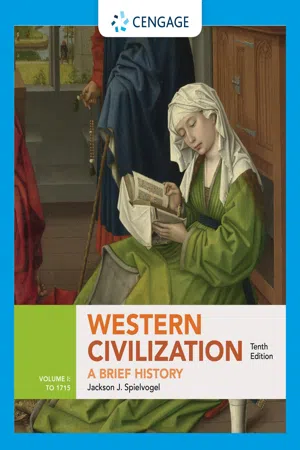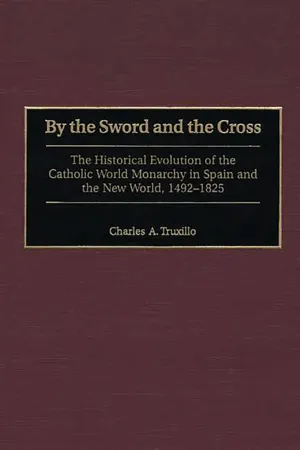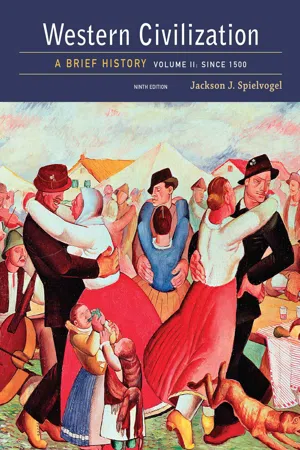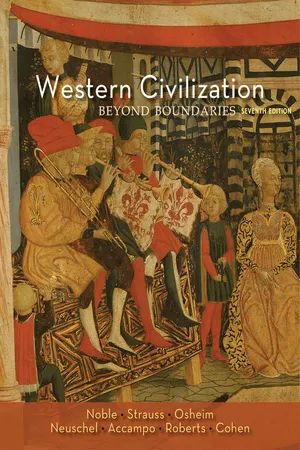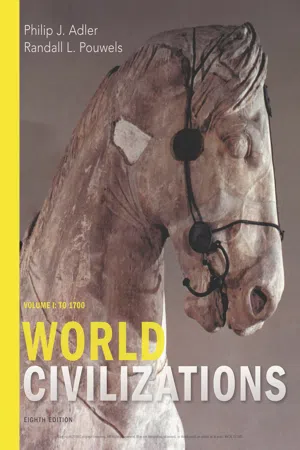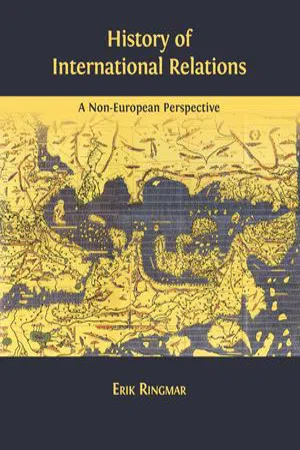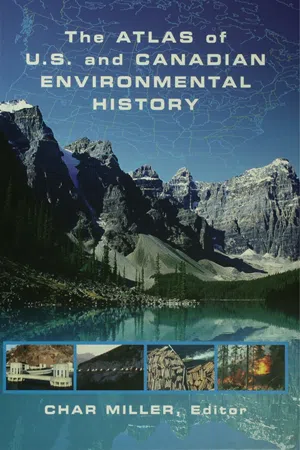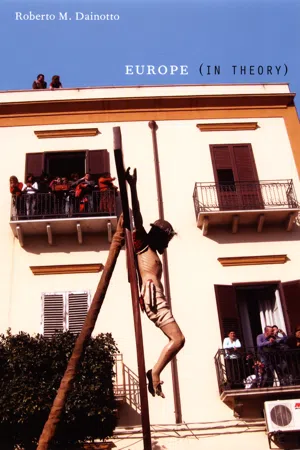History
European Exploration
European exploration refers to the period from the 15th to 17th centuries when European powers, such as Spain, Portugal, England, and France, embarked on voyages to discover new lands and establish trade routes. This era led to the colonization of the Americas, Africa, and Asia, and had a profound impact on global history, economics, and culture.
Written by Perlego with AI-assistance
Related key terms
1 of 5
11 Key excerpts on "European Exploration"
- eBook - PDF
Western Civilization
A Brief History, Volume I: to 1715
- Jackson Spielvogel(Author)
- 2019(Publication Date)
- Cengage Learning EMEA(Publisher)
At the beginning of the sixteenth century, European adventurers like Magellan had begun launching small fleets into the vast reaches of the Atlantic Ocean. They were hardly aware that they were beginning a new era, not only for Europe, but for the peoples of Asia, Africa, and the Americas as well. Nevertheless, the voyages of these Europeans marked the beginning of a process that led to radical changes in the political, economic, and cultural life of the entire world. Between 1500 and 1800, European power engulfed the globe. In the Americas, Europeans established colonies that spread their laws, religions, and cultures. In the island regions of Southeast Asia, Europeans firmly implanted their rule. In other parts of Asia and in Africa, their activities ranged from trading goods to trafficking in humans, permanently altering the lives of the local peoples. In all regions touched by European expansion, the indigenous peoples faced exposure to new diseases, alteration of their religions and customs, and the imposition of new laws. Experience an interactive version of this period in 14-1 On the Brink of a New World ■ 315 half of the fifteenth century, European monarchies had increased both their authority and their resources and were in a position to turn their energies beyond their borders. At the same time, by the end of the fifteenth century, European states had achieved a level of wealth and technology that enabled them to make a regular series of voyages beyond Europe. They now had remarkably seaworthy ships and reliable navigational aids, such as the compass and astrolabe (an instrument used to determine the position of heavenly bodies). One of the most important world maps available to Europeans at the end of the fifteenth century was that of Ptolemy, an astronomer of the second century c.e. - eBook - PDF
By the Sword and the Cross
The Historical Evolution of the Catholic World Monarchy in Spain and the New World, 1492-1825
- Charles A. Truxillo(Author)
- 2001(Publication Date)
- Praeger(Publisher)
Chapter 3 The Age of Discovery, Exploration, and Conquest, 1492-1556 SETTING THE STAGE At the end of the fifteenth century, European peoples living along the Atlantic coast began their great era of seaborne imperialism. The Age of Discovery and Explora- tion occurred at the same time as the Italian Renaissance. And though the two movements were not related, the intellectual expansiveness of the Renaissance made it easier for Europeans to assimilate aspects of the New World. By exploring and conquering the Americas, western Europeans were also able to increase the relative weight of their civilization in world affairs. Eventually the resources pro- vided by the New World tipped the age-old balance of Eurasian civilizations in favor of Europe. In this sense, the age of exploration was a turning point in world history (McNeill 1963). Since the retreat of Hellenism in the seventh century (A.D.) and the failure of the Crusades in the thirteenth century, Europeans had been con- fined to the western end of the Afro-Eurasian world island. When Columbus and Vasco de Gama sailed on their epic voyages at the end of the fifteenth century, it still seemed likely that the Ottoman Turks would overrun the whole of Christen- dom. A century later, the entire planet was beginning to feel the impact of the Euro- peans and their sailing gun ships, for the Atlantic maritime tradition facilitated European nations sailing with impunity throughout the world's oceans. Heavy-ship construction, necessary in the stormy waters of the North Atlantic, was combined, in the fifteenth century, with elements of Mediterranean naval technology, such as the lanteen sail, the compass, and portolan charts (Scammell 1989). The Portuguese were pioneers in the synthesis of maritime traditions. The vessels they built sailed throughout the world's oceans; moreover, they proved nearly invincible when armed with cannon. - eBook - PDF
Western Civilization
A Brief History, Volume II: Since 1500
- Jackson Spielvogel(Author)
- 2016(Publication Date)
- Cengage Learning EMEA(Publisher)
On the Brink of a New World Q F OCUS Q UESTION : Why did Europeans begin to embark on voyages of discovery and expansion at the end of the fifteenth century? Nowhere has the dynamic and even ruthless energy of Western civilization been more apparent than in its expansion into the rest of the world. By the late six-teenth century, the Atlantic seaboard had become the center of a commercial activity that raised Portugal and Spain and later the Dutch Republic, England, and France to prominence. The age of expansion was a cru-cial factor in the European transition from the agrarian economy of the Middle Ages to a commercial and industrial capitalistic system. Expansion also brought Europeans into new and lasting contacts with non-European peoples that inaugurated a new age of world history in the sixteenth century. The Motives for Expansion Lands outside Europe had long intrigued Europeans as a result of a large body of fantasy literature about “other worlds” that had blossomed in the Middle Ages. In the fourteenth century, the author of The Travels of John Mandeville spoke of realms (which he had never seen) filled with precious stones and gold. Other lands were more frightening and considerably less appealing. In one country, “the folk be great giants of twenty-eight foot long, or thirty foot long . . . . And they eat more gladly man’s flesh than any other flesh.” Farther north was a land inhabited by “cruel and evil women. And they have precious stones in their eyes. And they be of that kind that if they behold any man with wrath they slay him at once with the beholding.” 1 Other writ-ers enticed Europeans with descriptions of mysterious Christian kingdoms: the magical kingdom of Prester John in Africa and a Christian community in southern India that was supposedly founded by Thomas, an apostle of Jesus. Although Muslim control of Central Asia cut Europe off from the countries farther east, the Mongol con-quests in the thirteenth century had reopened the doors. - eBook - PDF
Western Civilization
Beyond Boundaries
- Thomas F. X. Noble, Barry Strauss, Duane Osheim, Kristen Neuschel(Authors)
- 2013(Publication Date)
- Cengage Learning EMEA(Publisher)
Cengage Learning reserves the right to remove additional content at any time if subsequent rights restrictions require it. 360 Chapter 13 European Overseas Expansion to 1600 the descendants of the native peoples who greeted the newly arriving Europeans—the Amerindians and the Aborigines, Maori, and Polynesians of the Pacific islands—remind us that the outsiders invaded another world. Their arrival brought modern warfare and epidemic diseases that virtually destroyed indigenous cultures. Spain sent its explorers west because the Portuguese already controlled the eastern routes to Asia around the African coast and because certain technological innovations made long open-sea voyages possible. Thus, the story includes national competition, the development of navigational techniques, and strategic choices. Finally, the Europeans overthrew the great empires of the Aztecs and the Inca, but the transfer of European culture was never as complete as the Europeans thought or expected. As our image suggests, the language and customs of the conquered peoples, blanketed by European language and law, survived, though the lands colonized by the Europeans would never again be as they had been before their encounter with the Old World. The European Background, 1250–1492 What did Europeans know about the wider world in the Middle Ages? By 1400, Europeans already had a long history of connections with Africa and Asia. They regularly traded with Arabs in North Africa, traveled through the Muslim lands on the east- ern edge of the Mediterranean, and eventually reached India, China, and beyond. After 1400, however, Europeans developed the desire and the ability to travel overseas to distant lands in Africa and Asia. Three critical factors behind the exploratory voyages of the fifteenth and early sixteenth centuries were technology, curiosity and interest, and geographic knowledge. - eBook - PDF
The Atlantic Experience
Peoples, Places, Ideas
- Catherine Armstrong, Laura M. Chmielewski(Authors)
- 2013(Publication Date)
- Red Globe Press(Publisher)
1 Navigation and Empire Origins of Empire The desire to explore the wider world and to establish settlements and empires in newly discovered territories was not new in 1500. There is a long and important pre-history to this desire. Although Europeans considered themselves at the centre of the known universe, Africans and Americans were also early exponents of using conquest to dominate their neighbours and develop new systems of governance, albeit with significant local variations. The language we use to discuss these new journeys and imaginings is significant. In talking about the European ‘discovery’ of America we are telling a particularly Eurocentric story, assuming that all innovation and progress was driven from and by Europe. The next chapter explores in more depth what happened when the peoples of the Atlantic world encountered each other for the first time. However, while it is important to acknowledge that Atlantic development repre-sents a departure from previous cultural patterns, this development can also be seen as a continuation and this chapter will explore how ancient and medieval models of empire and earlier technological advances and modes of exploration drove this inno-vation. Historian Charles Verlinden argues that this continuity can be traced from the fifth century onwards. While, prior to 1500, most Africans had not encountered a European in person, the ‘discovery’ of Europe by Africans had certainly begun before that date. Africans soon became aware of the benefits of contact with Europeans and in doing so had redefined themselves and their own identity. Ambassadors and delegations were sent to Europe from 1300 onwards as the European interest in African gold and slaves developed. The Barbary ports on the North African coasts were cosmopolitan places where Europeans of all nations mixed with Africans. The organization of West African society was hugely varied and constantly changing. - No longer available |Learn more
- Philip Adler, Randall Pouwels(Authors)
- 2016(Publication Date)
- Cengage Learning EMEA(Publisher)
Similarly, one might compare the army of the Copyright 2018 Cengage Learning. All Rights Reserved. May not be copied, scanned, or duplicated, in whole or in part. WCN 02-300 298 A Larger World Opens 22 I have come to believe that this is a mighty continent which was hitherto unknown . —christopher columbus T he unparalleled overseas expansion of Europe in the later fifteenth and early sixteenth centuries opened a new era of intercontinental contacts. What were the motives for the rapid series of adventuresome voyages? They ranged from Christian missionary impulses to the common desire to get rich. Backed to varying degrees by their royal governments, Portuguese, Spanish, Dutch, French, and English seafarers opened the world to European commerce, settle-ment, and eventual dominion. Through the Columbian Exchange , initiated in 1492, the New World entered European consciousness and was radically and permanently changed by European settlers. In most of the world, however, the presence of a relative handful of foreigners in coastal “factories” (as trading stations were called) or as occasional traders meant little change to traditional activities and attitudes. Not until the later eighteenth century was the Euro-pean presence a threat to the continuation of accustomed African, Asian, and Polynesian lifestyles. Maritime Exploration in the 1400s Overseas Empires and Their Effects ● Portuguese Pioneers ● The Spanish Empire in the Americas ● The African Slave Trade Opens ● Dutch and English Merchant-Adventurers Mercantilism The Columbian Exchange European Impacts on the World and Vice Versa ● The Fate of the Amerindians ● Racism’s Beginnings chapter outline WORLD MAP, c. 1500, WITH AMERICAS AT TOP This Spanish parchment map is the earliest extant depiction of the landmasses (in green) later named the Americas. The Age of Exploration depended on ever-improving maps to guide mariners over the open seas. - eBook - PDF
- Erik Ringmar(Author)
- 2019(Publication Date)
- Open Book Publishers(Publisher)
8. European Expansion 179 8. European Expansion A study of comparative international systems is by definition a historical study. There are no separate international systems to compare anymore. There is only one system — the system which first made its appearance in Europe in the late Renaissance, and which later came to spread to every corner of the globe. But “spread” is not the right word. This was not a matter of a process of passive diffusion. Rather, the eventual victory of the European international system was a result of the way the Europeans first came to “discover” and later to occupy and take possession of most non-European lands. This is a story of imperialism and colonialism. In this, the final chapter of the book, we will tell the story of how Europe for a while at the turn of the twentieth century came to rule the world. For most of its history Europe had quite a peripheral position in relation to everyone else. Europe was an international system turned in on itself, confident in its own culture and largely uninterested in what was going on elsewhere. Moreover, outsiders made only occasional forays into Europe — like the Berber kingdoms in the eleventh and twelfth centuries and the Mongols in the thirteenth century. What these outsiders found were a few impressive cathedrals, the occasional castle, but also a lot of desperately poor people, serfs without much food and without education. Before the year 1500, no European city was a match for the splendors of Baghdad, Xi’an, Kyoto or Tenochtitlan. Yet Europe eventually did become rich, powerful and important, and it came to have a profound impact on the rest of the world. In the first half of the fifteenth century, Europeans began to embark on sea voyages which took them down the western coast of Africa, and eventually far further afield. Here they discovered a number of commodities which found a ready market back home. - eBook - PDF
A Short History of Europe
From the Greeks and Romans to the Present Day
- A. Alcock(Author)
- 2002(Publication Date)
- Palgrave Macmillan(Publisher)
8 The Expansion of Europe and the First Colonial Empires 1500±1650ad As mentioned in the previous chapter, one of the consequences of the rise of the Ottoman Empire and the end of the Byzantine Empire was that traditional trade routes by land from Europe to India and China were blocked, leading to attempts to reach these areas by sea, and a period in world history was begun which would see Europe and Europeans come to dominate the globe. Leading the way were Portuguese, Spaniards and Italians, to be followed by Frenchmen, Englishmen and Dutchmen. The route to India and beyond was opened by the Portuguese. In 1487 Bartholomew Diaz reached the Cape of Good Hope. In 1498 Vasco da Gama rounded the Cape and went on to India, arriving at the town of Calicut. From thence the Portuguese sailed on further east, reaching Malaya in 1509, the Moluccas (New Guinea, Borneo, Timor) in 1513 and at last China in 1514. The search for a route to the east via the west was begun in 1492 by Christopher Columbus, a Genoese working for the King and Queen of Spain. In his first voyage he discovered only some Car- ibbean islands, but in later voyages he reached the central Amer- ican mainland. For a long time Columbus was credited with having discovered the New World, although today it is generally believed that the Vikings were the first to do so, landing in Labrador, New- foundland and even further south towards the end of the tenth 1 century. Newfoundland was re-discovered in 1497 by the Floren- tine Giovanni Caboto (John Cabot), working for Henry VII of England. In the first half of the sixteenth century, the Portuguese Pedro Cabral discovered Brazil; the Florentine Amerigo Vespucci dis- covered the mouth of the Amazon and Uruguay, and the Spaniard Juan de Solis the River Plate. In the years 1519±22 a Spanish expedition led by a Portuguese, Ferdinand Magellan, was the first to circumnavigate the world. In doing so it rounded Cape Horn, penetrating the Pacific from the west. - Char Miller(Author)
- 2003(Publication Date)
- Routledge(Publisher)
While the explorers provided first-hand accounts of the territory and the continent’s rich resources, cartographers in Europe painstakingly pieced together a jigsaw of geographical information, converting this mythic region into a tangible territory read to be settled and exploited. Thus began the transformation of a romantic and bountiful wilderness into a rapidly populated and commercially important continent. Early Explorations. A handful of Europeans have been credited for what was, in reality, the collective effort of thousands of explorers, cartographers, missionaries, traders, and land speculators. Credit for discovering the New World is popularly given to Italian-born mariner Christopher Columbus, whose four voyages across the Atlantic Ocean between 1492 and 1504, under the sponsorship of the Spanish monarchy, began the European conquest of the Americas. Claims that Italian navigator Amerigo Vespucci reached the mainland first are generally disputed by scholars, but Vespucci is credited as the namesake of “America” and with charting much of the northern coast of South America. Neither Columbus nor Vespucci was the first European to reach North America: Icelandic explorer Leif Ericson is believed to have reached the coast of Labrador in about 1000 A.D Columbus’s explorations led to Spain’s domination of the southern part of the North American continent during the 1500s (see also 16–17); other explorers, including John Cabot, explored the north. Cabot was an Italian navigator sailing under the mandate of England’s King Henry VII “to seeke out, discouer, and finde whatsoever isles, countreys, regions or prouinces of the heathen and infidels whatsoeuer they be, and in what part of the world soeuer they be.” When he reached the North American mainland in 1497, Cabot established England’s claim to the entire northern continent. The claim to such a vast area was tenuous, not least because French and Dutch mariners were also actively exploring the region- eBook - PDF
General History of the Caribbean UNESCO Vol 2
New Societies: The Caribbean in the Long Sixteenth Century
- NA NA(Author)
- 2019(Publication Date)
- Palgrave Macmillan(Publisher)
Nor must we forget the survival of ancient myths, legends and the faith in all kinds of exotica. The colonization of the East should also be taken as a point of comparison. In the narrower sense, the prehistory of Atlantic expansion includes the consolidation of the trading empires of Italian city-states in the Mediterranean regions and their colonial experience in the Black Sea and Eastern Mediterranean, the progress of the medieval Iberian Reconquista, and the recovery of the Iberian Peninsula from the dominance of the Moors which reached the Straits of Gibraltar in the mid-thirteenth century. This permitted Christian navigation from the Mediterranean out in to the Atlantic so that regular shipping and trade contacts were soon established between the Mediterranean and Western Europe or the North Sea region. The Iberian kingdoms of Castile and Portugal quickly rose to the status of European maritime powers. They also became important centres for long-distance European trade where Italian and French merchants met with their counter- parts from Flanders and the Hanseatic League. Here too, seagoing ships began to be built. They were able to sail on the Atlantic with its high waves and long swell. The transition from the prevailing coastal shipping to high- sea navigation then became possible. The extent to which these develop- ments stimulated the imagination of the seafaring cities is apparent from the fact that, in 1291, a Genoan expedition tried to sail southwards along the African coast but failed to return from this venture. In the first third of the fourteenth century, the Genoans rediscovered the Canary Islands which had already been known in ancient times. At much the same period Marco Polo's report on his voyage to China caused a sensation in Europe. The desire to reach Asia by the sea route was now rekindled. In parallel, the conviction that the earth was round took root. - eBook - PDF
- Roberto M. Dainotto(Author)
- 2007(Publication Date)
- Duke University Press Books(Publisher)
From this process of di√erentiation, personification, and identifica-tion, a sclerotic and one-way consciousness of Europe—both in its geo-graphic and in its moral and political sense—was cementing between the sixteenth and the seventeenth centuries. England, in the meantime, was rising as a major player in European a√airs. The Portuguese state (which had begun European expansion overseas in 1415 with the seizure of the Muslim port of Ceuta, followed by Madeira in 1420, Mauritania in 1448, and the Congo River in 1482), and the Spanish crown (which had fi-nanced Columbus in 1492) were quickly declining, su√ocated by debts contracted with foreign merchants to cover the military and commercial costs of their colonies overseas. A more entrepreneurial class of mer-chants, instead, had begun British expansion overseas: its exploitation of the colonies profited the state enough cash in taxation to grant, in turn, su≈cient military power to consolidate possession, protect the routes from pirates, and monopolize commerce with the Orient. Once British expansion was in motion, the system kept reproducing and amplifying itself: exploitation of the colonies’ riches and labor power kept generat-ing new wealth; exploitation of the colonies’ preexisting ethnic, caste, or tribal divisions kept providing the low-cost bureaucratic and military apparatuses for the control of the territories. Marginal to Europe in terms of both geography and demography, England soon became not only a visible part of Europe but its antonomasia. For the explorer of Francis Bacon’s New Atlantis , therefore, it was only natural to compare Atlantis’s food not simply to England’s but to ‘‘any collegiate diet that I have known in Europe’’ (107); to desire to ‘‘see Europe’’ in the moment of despair (108); or to speak comfortably of ‘‘we in Europe’’ (113). Also, William Shakespeare’s Sebastian, in The Tempest , could confidently talk of ‘‘our Europe’’ (act 2, scene 1, verse 103).
Index pages curate the most relevant extracts from our library of academic textbooks. They’ve been created using an in-house natural language model (NLM), each adding context and meaning to key research topics.
